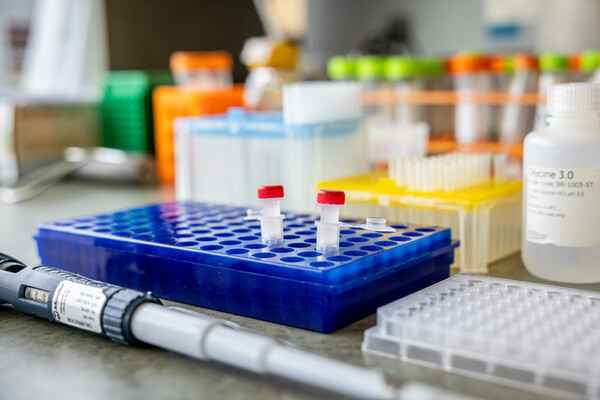Main Second Level Navigation
New Funding Will Advance Research In Genomics And Regenerative Medicine

Five Donnelly Centre labs have been awarded new funding from the federal government to advance their research programs.
Donnelly Centre investigators Brenda Andrews, Ben Blencowe, Igor Stagljar, Andy Fraser and Cindi Morshead were awarded more than $6 M for projects in functional genomics, proteomics, metabolomics and regenerative medicine, respectively, from the Canadian Institutes of Health Research, a chief federal government agency supporting medical research.
“I congratulate my colleagues on securing funding for their vital research that will reveal new biological insights, expand our understanding of disease and pave the way for new treatments,” said Stephane Angers, Director of Donnelly Centre and Charles H. Best Chair in Medical Research.
The awarded projects are:
Exploring genetic network dynamics in the context of diverse genetic backgrounds
A pioneer in functional genomics, Brenda Andrews, a University professor of molecular genetics and former director of the Centre, has been at the forefront of efforts seeking to establish how information in the genome, or genotype, determines trait manifestation in an organism, known as phenotype. As part of a long-term collaboration with Donnelly colleague Charlie Boone, Andrews has mapped networks of interactions between genes, showing that genes rarely act independently to determine phenotype. The picture is further complicated by the fact that unique sets of genetic variants that an individual carries in their genome influence trait inheritance in ways that are poorly understood. The new funding will support the development of unique datasets and tools that will reveal how groups of genes interact with each other and how networks of genetic interactions are rewired in response to different genetic backgrounds. The insights gleaned will be important for advancement of personalized medicine, in particular the development of predictive models of disease risk based on individual genome sequence.
Learn more about about how genetic networks can be influenced by genetic background.
Exon and intron resolution functional genomics
Ben Blencowe, a professor of molecular genetics in the Donnelly Centre, will use his CIHR funding to develop new approaches for investigating how alternative splicing (AS), a process by which cells regulate and diversify their protein content, impacts cell biology. Blencowe is world renowned for his research in the field. He and others have shown that the majority of human gene transcripts are alternatively spliced and have discovered networks of splicing events that are critical for mammalian development. Alternative splicing is most pronounced in the nervous system where it plays a major role in establishing the complexity of cell types required for the development and functioning of the mammalian brain. Research so far has focused on taking bulk measurements of AS events from many cells at a time, calling for new approaches to be developed to be able to discover and understand the function of individual exons and introns, as well as how they impact biology at the level of single cells. The awarded project will not only yield novel approaches that will be of interest to researchers across the world, but it also has the potential to shed light on the molecular mechanisms underlying of neurological disorders such as autism and schizophrenia, which are associated with misregulated splicing.
Learn more about alternative splicing and its effect on the brain.
A reference interactome map of human ATP-binding cassette (ABC) transporters
Igor Stagljar, a professor of molecular genetics and biochemistry at the Donnelly Centre, will use the funds awarded by CIHR to apply a high-throughput technology for identifying protein interactions, recently developed in his lab, to a clinically relevant group of human proteins known as ABC transporters. ABC transporters are located in the membranes of cells and play many important roles, including pumping out toxins, a process that has been co-opted by cancer cells to provide resistance to chemotherapeutic drugs. Previously, professor Stagljar’s lab applied their technology, called Mammalian Membrane Two-Hybrid High-Throughput Screening (abbreviated “MaMTH-HTS”), to the Cystic Fibrosis Transmembrane Conductance Regulator (CFTR), an ABC transporter whose mutation causes Cystic Fibrosis. Their work revealed hundreds of new CFTR-interacting proteins, many with potential roles in regulating disease severity. They will now apply MaMTH-HTS to all 43 remaining ABC transporters found in human cells to build detailed maps of their interacting partners. The ultimate goal of this research is to reveal proteins that could be targeted to modulate transporter function for a wide range of therapeutic applications.
Learn more about how MaMTH helped reveal clinically relevant targets for cystic fibrosis.
Reading metabolites with DNA barcodes
Work is ongoing in the lab of Andy Fraser, a professor of molecular genetics at the Centre, that could transform detection of small molecules produced by the body, also known as metabolites. They include sugars, amino acids, lipids and other compounds, whose composition differs between health and disease, and as such they hold great promise for personal health monitoring. However, gold standard methods for metabolite detection require expensive mass spectrometry instruments that are housed in centralized facilities with consequently long turnaround times. Furthermore, unlike DNA, metabolites cannot be amplified, making their detection difficult in small samples such as tears or sweat that are easy to collect for daily health checks. The Fraser lab developed a new method that solves both these problems by using DNA barcoding to indirectly identify small molecules in complex fluids. Each small molecule is detected by a different sensor and each sensor releases a different DNA barcode. Because DNA can be easily amplified by polymerase chain reaction, barcoding enables the detection of both abundant and scarce metabolites alike. The team will use the new funds to further advance their technology towards research applications and ultimately personal health monitoring.
Design and implementation of novel multimodal electrodes for neural precursor activation to promote neural regeneration
Cindi Morshead was awarded funding to continue to develop deep brain stimulation approaches that hold promise for restoring brain health after a stroke injury. Morshead, who is also Chair of the Division of Anatomy at the Department of Surgery, is renowned for her research that seeks to harness the potential of resident neural stem cells in the brain to replace the cells lost due to a lack of oxygen following stroke. The lab recently showed that electrical stimulation promotes activation of stem cell-derived neural precursor cells leading to their expansion, migration and generation of new neural cells. The new funding will be used for the design of novel electrodes and protocol optimization to not only activate the precursor cells but to also promote brain plasticity through the delivery of regenerative factors in a local and controlled fashion. The treatment success will be tested in a preclinical mouse model of stroke by measuring brain health and relevant motor behaviour. The research has the potential to transform the treatment of brain injuries and disorders for which there are presently no cures.
Follow us on LinkedIn and Twitter to keep up with Donnelly Centre news.
News



